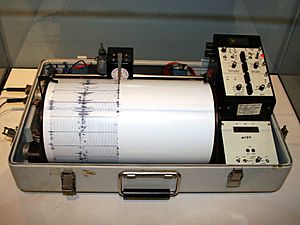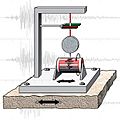Seismometer facts for kids
A seismometer (say: size-MOM-uh-ter) is a special tool that measures how the ground moves. It can detect tiny shakes or big movements caused by earthquakes, large explosions, or other things that make the Earth vibrate.
When the ground shakes, a seismometer creates a record called a seismogram. These records are like a map of the Earth's inside. They help scientists understand what the Earth is made of deep down. Seismograms also help us find where earthquakes happen and how strong they are.
The word "seismometer" comes from ancient Greek words. Seismós means "a shaking" or "quake," and métron means "measure." So, a seismometer is a "shake-measurer."
Scientists use a technique called seismic tomography to create detailed pictures of the Earth's interior. This is like using an X-ray machine for the Earth, but with seismic waves instead of light.
Contents
How Do Seismometers Work?
Seismometers work by using a weight that hangs freely. When the ground shakes, the main part of the seismometer moves with the ground. But the hanging weight tries to stay still because of something called inertia.
Imagine you are on a bus that suddenly stops. Your body keeps moving forward for a moment. That's inertia! In a seismometer, the weight's inertia helps it stay steady while the rest of the instrument moves.
A pen or a sensor is attached to this steady weight. It records the ground's movement on a spinning drum or sends signals to a computer. This creates the seismogram, which shows how much and how fast the ground moved.
Different Types of Seismometers
There are different kinds of seismometers. Some are designed to measure up-and-down movements. Others measure side-to-side movements. Modern seismometers are very sensitive. They can detect ground movements from earthquakes happening thousands of miles away.
Many seismometers are placed deep underground or in quiet places. This helps them avoid picking up small vibrations from traffic or people walking.
Why Are Seismometers Important?
Seismometers are super important for many reasons. They help us learn about earthquakes. By studying seismograms, scientists can figure out:
- Where an earthquake started.
- How deep it was.
- How strong it was (its magnitude).
- How fast the seismic waves traveled.
This information helps people prepare for future earthquakes. It also helps engineers design stronger buildings that can withstand shaking.
Exploring Earth's Inside
Seismometers also help us understand what's inside our planet. When an earthquake happens, it sends waves through the Earth. These waves change speed and direction as they pass through different materials. By studying how these waves travel, scientists can create maps of the Earth's layers, like the crust, mantle, and core.
The History of Seismometers
The very first known seismoscope was invented in China in 132 AD by a smart inventor named Zhang Heng. His device was a large bronze jar with dragons around the outside. Each dragon held a ball in its mouth. Below each dragon was a toad with its mouth open.
When an earthquake happened, even a small one far away, a mechanism inside the jar would make one of the dragons drop its ball into a toad's mouth. This showed the direction of the earthquake. It was a very clever invention for its time!
Modern seismometers started to develop in the late 1800s. Scientists like John Milne created more advanced instruments that could record ground motion more accurately. Over time, these tools became more precise and could detect even the smallest tremors.
Images for kids
-
Replica of Zhang Heng's seismoscope Houfeng Didong Yi
-
Milne horizontal pendulum seismometer. One of the Important Cultural Properties of Japan. Exhibit in the National Museum of Nature and Science, Tokyo, Japan.
See also
 In Spanish: Sismógrafo para niños
In Spanish: Sismógrafo para niños










